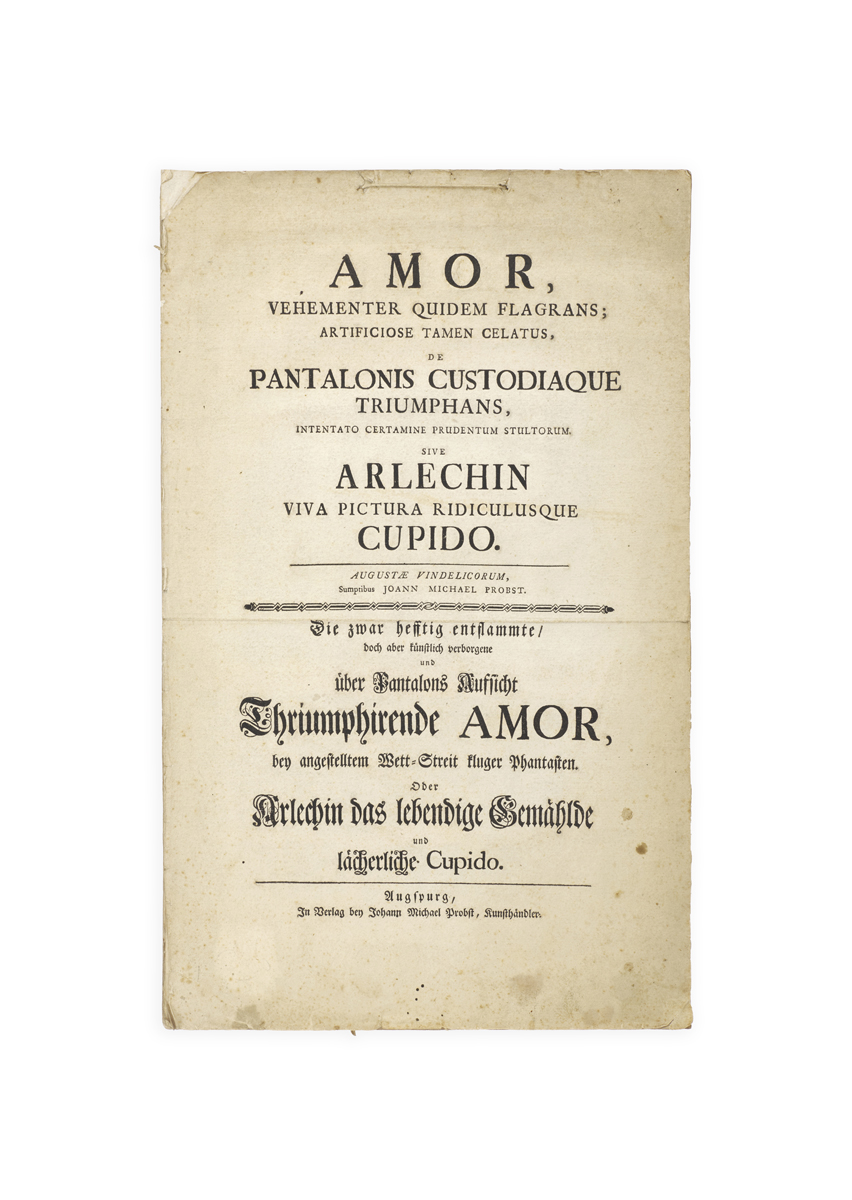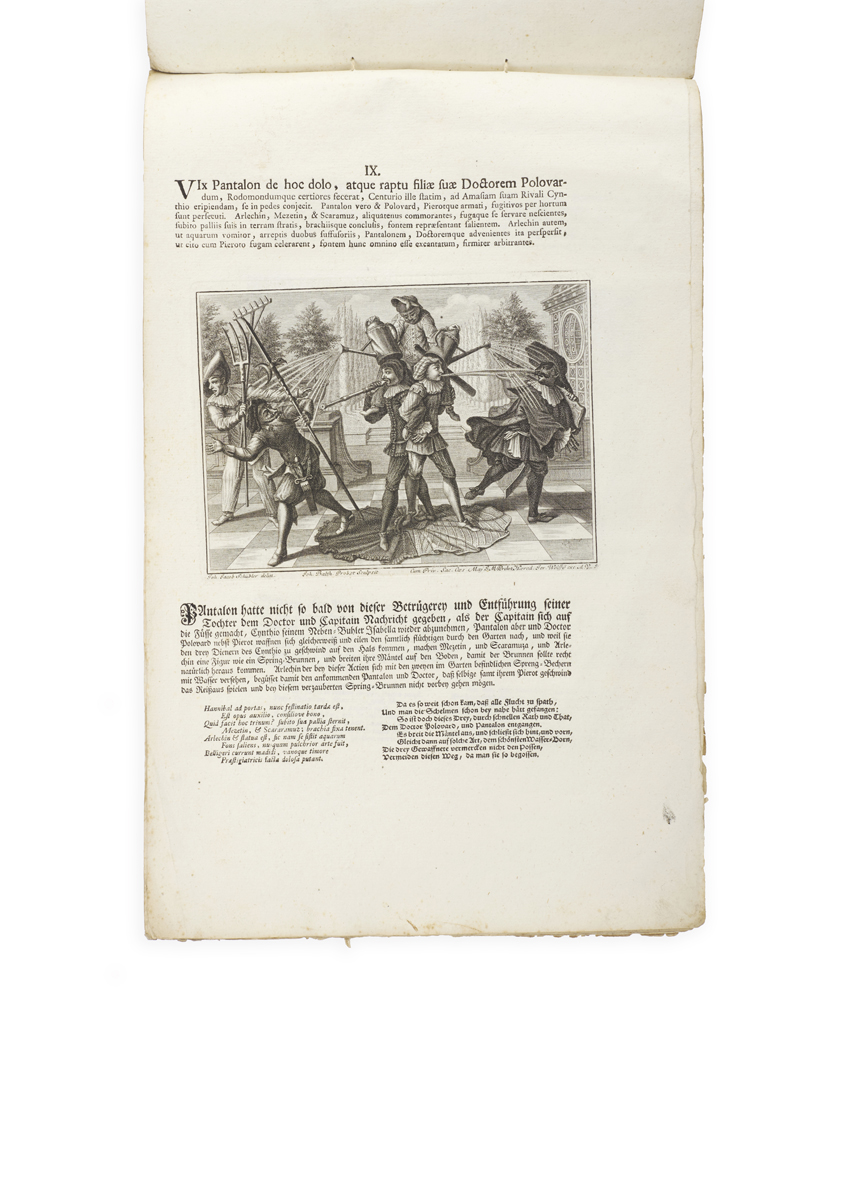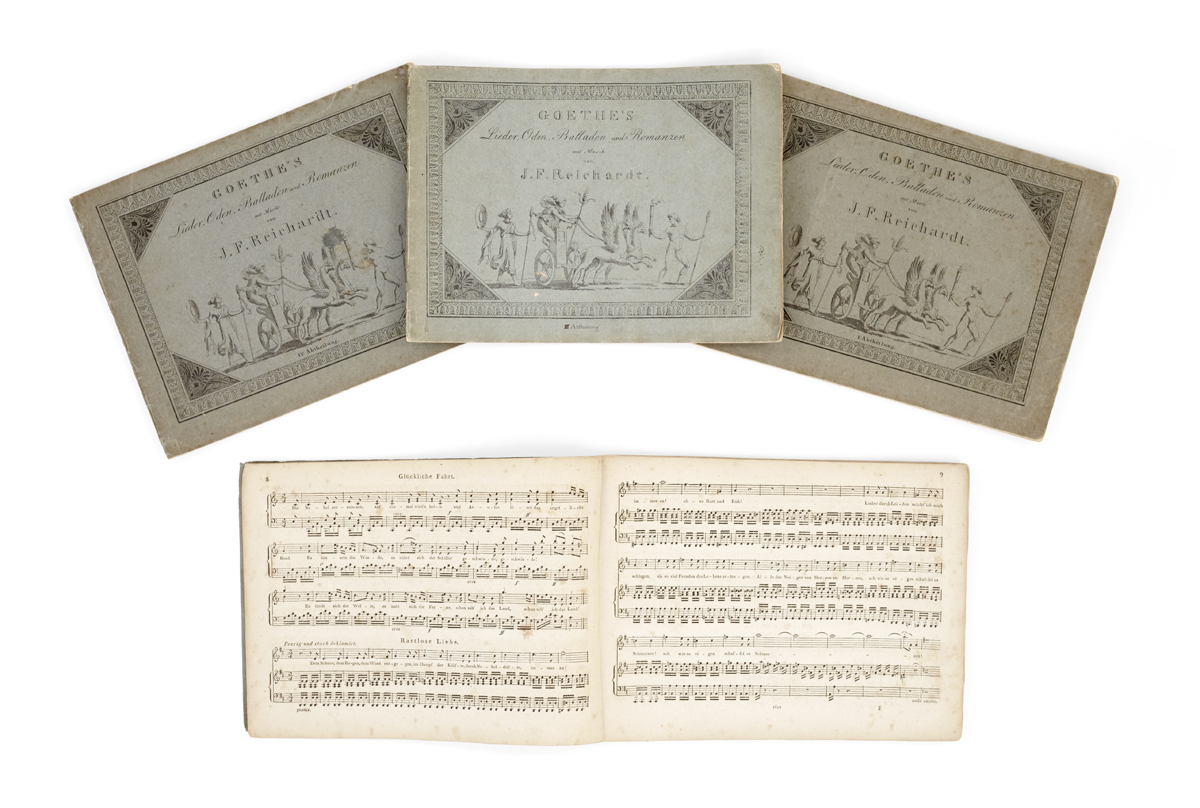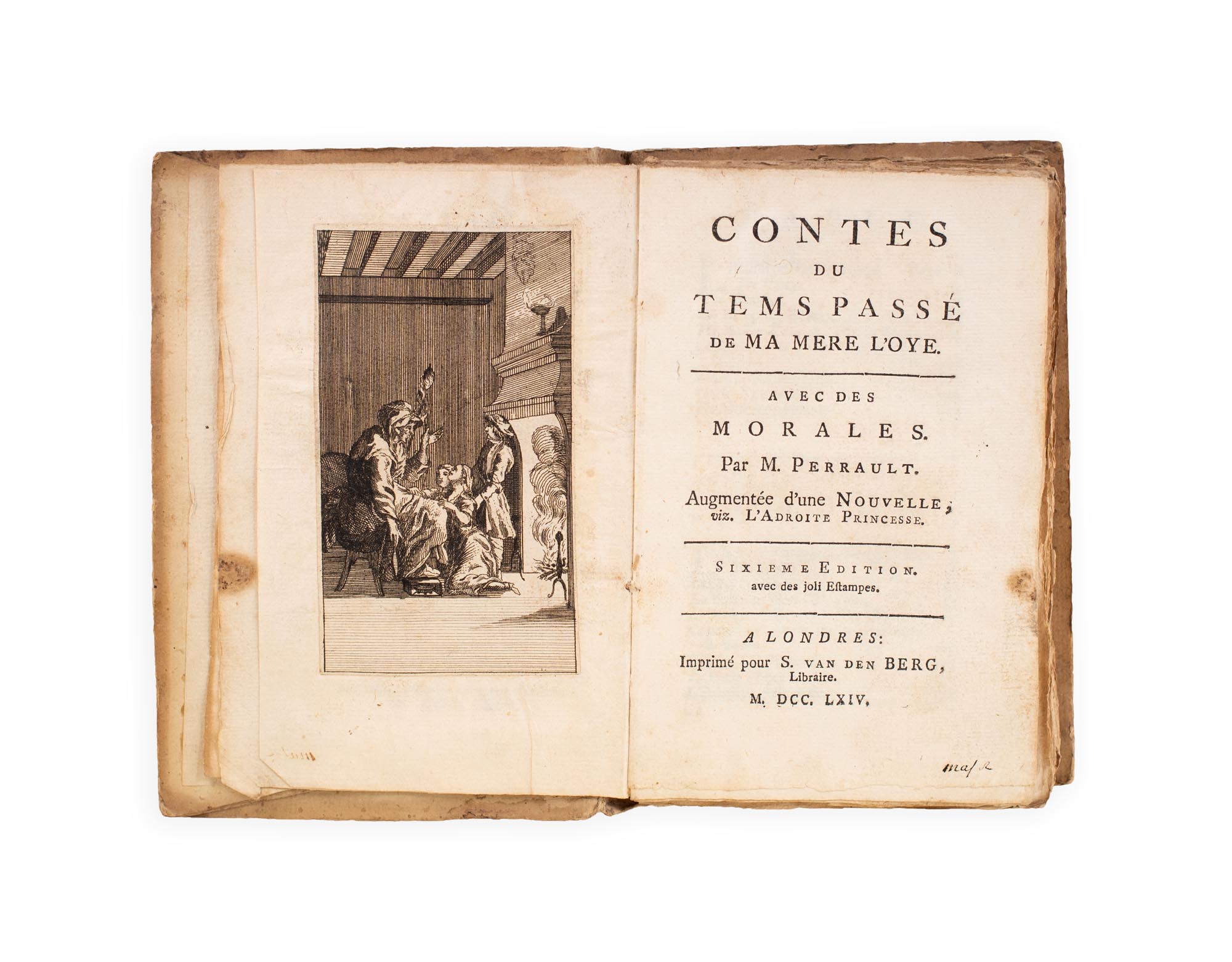


‘GRACEFUL FRIVOLITY AND WHIMSICAL BURLESQUE’
SCHÜBLER, Johann Jakob.
Amor, vehementer quidem flagrans; artificiose tamen celatus, de Pantalonis custodiaque triumphans, intentato certamine prudentum stultorum. Sive Arlechin viva pictura ridiculusque Cupido … Die zwar hefftig entflammte doch aber künstlich verborgene und über Pantalons Aufsicht triumphirende Amor, bey angestelltem Wett-Streit kluger Phantasten. Oder Arlechin das lebendige Gemälde und lächerliche Cupido.
Augsburg, Johann Michael Probst, [c. 1770?].
Folio, ff. [1 (title)], XII; printed to rectos only, with 12 copper-engravings (c. 180 x 135 mm) each with corresponding Latin and German text respectively above and below; title slightly soiled with one upper blank corner chipped and two subtle repairs at top-edge, some light (mostly marginal) spotting, a few corners creased, margin of last leaf frayed, nevertheless a very good copy, with the illustrations clean and strongly impressed; remarkably well-preserved, stab-stitched at head as issued.

Added to your basket:
Amor, vehementer quidem flagrans; artificiose tamen celatus, de Pantalonis custodiaque triumphans, intentato certamine prudentum stultorum. Sive Arlechin viva pictura ridiculusque Cupido … Die zwar hefftig entflammte doch aber künstlich verborgene und über Pantalons Aufsicht triumphirende Amor, bey angestelltem Wett-Streit kluger Phantasten. Oder Arlechin das lebendige Gemälde und lächerliche Cupido.
Rare series of twelve engravings inspired by the Italian commedia dell’arte, one of the most beautiful books of the German Rococo, engraved by Johann Balthasar Probst after original illustrations by the architectural painter, sculptor, and mathematician Johann Jakob Schübler.
Born in Nuremberg, Johann Jakob Schübler (1689–1741) studied art under the tutelage of several prominent Nuremberg-based artists, including the architectural painter J.A. Graff and the director of the Nuremberg Academy of Fine Arts Georg Christopher Eimmart, before going on to study mathematics and physics whilst in Copenhagen. In 1717, he produced his first major architectural accomplishment, the triumphal arch in Sulzbach, although he failed to obtain the sought-after position of court architect. In the following years, he dedicated himself to a range of paintings and illustrations, most of which depicted either architectural designs or a vast array of subjects, including altars, pipe organs, libraries, beds, clocks, garden gates, and fountains. It was during this period that he developed a working relationship with Johann Balthasar Probst (1673–1748), son-in-law to Schübler’s publisher Jeremias Wolff; Probst would go on to act as Schübler’s chief engraver (and later publisher) for the rest of his working life.
The present series, first published in 1729 by Wolff, comprises twelve engravings by Probst following Schübler’s original designs, an accompanying bilingual Latin and German text, and eight lines of Latin hexameters translated into German Alexandrines, both verse and prose likely the work of Schübler himself. They tell the story in pantomime of the love affair between Cynthio and Isabella, daughter of Pantalon. According to Heinrich Gursching, this series is the only ‘purely artistic’ work of Schübler’s which survives, ‘a gallant love story with conventional characters, in particular the obliging servants Harlequin, Mezzetin, Scaramouche, and Bagolin’ produced ‘shortly before [Schübler’s] turn towards philosophical teaching, which must have quelled in him the persona of the lightly-clad, fantastical etching-poet’ (pp. 44-45). Of this particular narrative, Lawner comments that ‘the scenario that inspired Probst is known only through this album, but is surprisingly complete in its twelve episodes. It must have been elaborately produced, as we may deduce from the intricate scenery and props in his illustrations’ (Lawner, Harlequin on the Moon: Commedia dell' Arte and the Visual Arts(1998), pp. 122-126).
According to Lanckoronska and Oehler, ‘the volume forms a bridge between a Tafelwerk and an illustrated book, bringing together the beauty of an important individual work of art with that of an image which brings to life the accompanying text, and it belongs to the most enticing productions of southern German Rococo … in a series of 12 leaves we are told a fable of Commedia dell’Arte in both German and Latin, in prose and in verse, in words and in pictures. Everything in this volume – the text, the poems, the illustrations – exudes the graceful frivolity and whimsical burlesque of such comedies … The artists of the work, the draughtsman Johann Jakob Schübler and the engraver Johann Balthasar Probst, have forged a symbolic depiction so in harmony with the text that one can seem to hear the accompanying music playing. Schübler, the Nurembergian architect … is in all of his achievements filled with the most exuberant fantasy. Here, where he is no longer forcibly constrained by some dry subject, he pours out all he has in the way of ideas in immeasurable abundance. Probst … engraved Schübler’s inventions with equally brilliant inventiveness’ (Anna Maria Isabella Lanckoronska & Richard Oehler, Die Buchillustration des XVIII. Jahrhunderts (Leipzig 1932) I, p. 36, trans.). Few works of the period can excite such eulogies.
These particular illustrations served as models for a series of ten porcelain figures, designed around 1765 by Wenzel Neu for the porcelain factory of Kloster-Veilsdorf, as well as for decorated earthenware in Italy (see Maiolica e incisione: Tre secoli di rapporti iconografici, exhibition catalogue, Castello Sforzesco (Milan, 1992), nos 73a–b).
Brunet I, col. 240; Gay-Lemonnyer I, col. 102; Graesse I, 106; Jowers & Cavanagh, Theatrical costume... 3062; Lanckoronska-Oehler I, 36; Lipperheide Ucc 5; Millard, Northern European Books 115; Thieme-Becker XXX, p. 309. See Heinrich Gursching, ‘Johann Jacob Schübler: Ein Nürnberger Baumeister des Barockzeitalters‘ in Mitteilungen des Vereins für Geschichte der Stadt Nürnberg 35 (1937), pp. 17-57.

